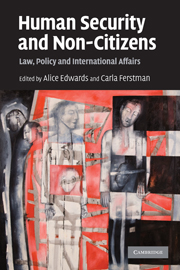Book contents
- Frontmatter
- Contents
- About the editors
- About the contributors
- Preface
- Acknowledgements
- Part I Human security, human rights and human dignity
- Part II Physical and legal security, armed conflict and refuge
- Part III Migration, development and environment
- 7 Empowering migrants: human security, human rights and policy
- 8 Labour migration management and the rights of migrant workers
- 9 Socio-economic rights, human security and survival migrants: Whose rights? Whose security?
- 10 An insecure climate for human security? Climate-induced displacement and international law
- 11 Human security and trafficking of human beings: the myth and the reality
- Part IV National security and the ‘war on terror’
- Index
11 - Human security and trafficking of human beings: the myth and the reality
Published online by Cambridge University Press: 17 February 2011
- Frontmatter
- Contents
- About the editors
- About the contributors
- Preface
- Acknowledgements
- Part I Human security, human rights and human dignity
- Part II Physical and legal security, armed conflict and refuge
- Part III Migration, development and environment
- 7 Empowering migrants: human security, human rights and policy
- 8 Labour migration management and the rights of migrant workers
- 9 Socio-economic rights, human security and survival migrants: Whose rights? Whose security?
- 10 An insecure climate for human security? Climate-induced displacement and international law
- 11 Human security and trafficking of human beings: the myth and the reality
- Part IV National security and the ‘war on terror’
- Index
Summary
Introduction
This chapter considers the relevance of human security to people trafficking. It concludes that human security as an idea may be helpful in guiding states' behaviour with regard to the victims of traffickers but rejects the criticism that the existing legal regime with regard to trafficking is unreasonably skewed in favour of state security at the expense of the victims of trafficking.
Trafficking of human beings (human trafficking) is a major threat to the security of people and states the world over. The essence of trafficking is that a person is taken from one country to another (or from one region to another region in the same country), by one or more of a variety of means involving some kinds of force and/or deception, with the aim of exploiting that person's labour at the destination (and sometimes in transit too).
The practice has been linked with and compared to slavery, and it certainly can involve aspects of slavery, in particular with regard to the restrictions placed on the freedom of movement of the individual and the fact that victims may not receive appropriate payment for their labour. Typically, human trafficking will entail the recruitment of a person for some employment in another country, though often the real nature of the work, or the conditions of the work, will be concealed from the victim. The individual will then travel to the destination country, directly or via transit states, perhaps crossing borders illegally.
- Type
- Chapter
- Information
- Human Security and Non-CitizensLaw, Policy and International Affairs, pp. 404 - 418Publisher: Cambridge University PressPrint publication year: 2010
- 4
- Cited by



